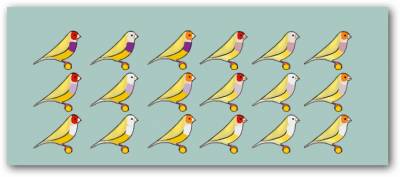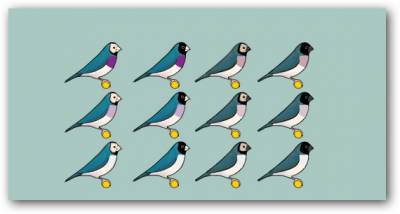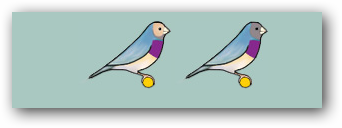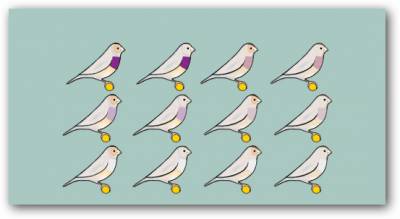Приведеный ниже список употребляемых в тексте сокращений, поможет вам быстрее разобраться в схемах скрещивания гульдовых амадин
Male, Cock - Самец
Sire - Самец - производитель
Hen, Female - Самка
Dam -Самка - производительница
RH (Red Head) - Красная голова
BH (Black Head) - Черная Голова
OH (Orange Head) - Оранжевая Голова
YH (Yellow Head) - Желтая Голова
PB (Purple Breast) - Фиолетовая Грудь
LB (Lilac Breast) - Сиреневая Грудь
WB (White Breast) - Белая Грудь
NB (Normal Body ) - номинативное (природного зеленого окраса) тело
YB (Yellow Body) - желтое тело (спинка)
BB (Blue Body) - cинее тело
SB ( Silver Body) - серебристое тело
WB (White Body) - белое тело
значок " / " (Split) - обозначает сцепленный, (в разговорном - щепный )
SF (Single Factor) - Однофакторный
DF (Double Factor) - ДвухфакторныйPastel - Пастельный
Dilute - Осветленный
Gouldian hens come in four body colors: green, yellow, blue, and silver. Gouldian cocks
come in six body colors: green, dilute, yellow, blue, pastel, and
silver. Note: Certain body colors affect the expression of certain head
colors: the yellow gene suppresses the expression of black coloration,
and the blue gene suppresses the expression of red and yellow
coloration. This will be explained more in detail below.
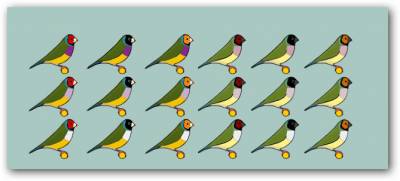
Green body is a sex-linked gene which is incompletely
dominant to yellow body (also a sex-linked gene). Green body is
dominant to blue body (which is autosomal). Because it is a sex linked
gene, cocks can be double-factor (DF) or single-factor (SF) for green
body (the other factor being yellow body) while hens can only ever be
single-factor (SF). Green body can occur in combination with any head or
breast color; however, when a cock bird is single-factor for green body
and single-factor for yellow body, and he also has a purple chest, he
appears dilute (as explained below). If he is single-factor for green
body (or, equally, single-factor for yellow body) with a white or lilac
chest, he appears yellow. This occurs because body color is a polygenic
trait which is influenced not only by the color coded for on the sex
chromosomes, but also by the autosomal breast color (and blue body)
genes. Therefore only the white breasted single factor yellow body cock
could be considered "split" for green body, because he would appear to
be a yellow bird even though he is carrying a green gene.
Yellow body is a sex-linked gene which is incompletely
dominant to green body (also a sex-linked gene). Yellow body is
dominant to blue body (which is autosomal). Because it is a sex linked
gene, cocks can be double-factor (DF) or single-factor (SF) for yellow
body (the other factor being green body) while hens can only ever be
single-factor (SF). Yellow body can occur in combination with any head
or breast color; however, when a cock bird is single-factor for yellow
body and single-factor for green body, and he also has a purple chest,
he appears dilute (as explained below). If he is single-factor for
yellow body (or, equally, single-factor for green body) with a white or
lilac chest, he appears yellow. This occurs because body color is a
polygenic trait which is influenced not only by the color coded for on
the sex chromosomes, but also by the autosomal breast color (and blue
body) genes. The yellow gene suppresses the expression of the color
black on the birds, so any area which would normally be black on a green
bird appears white or off-white on a yellow bird. This is why
genetically black headed yellow birds appear to have white or near-white
heads.
Dilute is the phenomenon of combining a 'yellow' Z
(sex-linked) chromosome with a 'green' Z (sex-linked) chromosome in a
purple-breasted bird. (Obviously since two Z chromosomes are required
for this to occur, dilute birds can only be cocks.) Hens can never be
dilute. The single yellow body gene "battles" with the green body gene
for expression, and so a little of each gene is expressed making the
bird not green nor yellow but a shade in between. This is the hallmark
of incomplete dominance. Dilute will never occur in a white breasted
cock (since then the bird who is SFYB will appear yellow), but dilute
birds can be split for white breasted. Because the yellow gene
suppresses the expression of black coloration and because the green gene
mutes the effects of the yellow gene, any normally black area on the
bird will appear grey (as opposed to white), so black headed birds will
have grey heads.
Blue body is an autosomal recessive gene, so both cocks and
hens can be double-factor (DF) and express the color blue or
single-factor (SF) and be "split" for blue body. Birds will appear blue
in color only when a bird carrying only "green" sex chromosome(s) (as
opposed to yellow) is also DF for the blue body gene. This body color
can occur in combination with any head or breast color, however, because
the blue gene suppresses the expression of red and yellow, any bird
with a genetically red or yellow head will appear to have a salmon
colored head, and the normally yellow belly will appear off-white.
Pastel is the phenomenon of combining a 'yellow' Z
(sex-linked) chromosome with a 'green' Z (sex-linked) chromosome and
double-factor blue genes in a purple-breasted bird. (Obviously since two
Z chromosomes are required for this to occur, pastel birds can only be
cocks.) Hens can never be pastel. Pastels can be thought of as "blue
dilutes." Pastel will never occur in a white breasted cock (instead the
bird who is SFYB and DF blue body will appear silver as explained
below), but pastel birds can be split for white breasted. Because the
yellow gene suppresses the expression of black coloration and because
the green gene mutes the effects of the yellow gene, any normally black
area on the bird will appear grey (as opposed to white), so black headed
birds will have grey heads. Also because the blue genes suppress the
expression of red and yellow, any areas of the bird which would normally
be red or yellow (such as the head or yellow belly of the bird) appear
salmon or off-white, respectively, in color.
Silver body occurs when yellow body genes are combined with
blue body genes. A genetically yellow bodied blue bird will appear
silver in phenotype. (A SFYB DF blue cock will ONLY appear silver if he
is white breasted, otherwise he will appear pastel.) Because the
yellow gene suppresses the expression of black coloration and because
the blue genes suppress the expression of red and yellow, the entire
body of the bird appears white or off-white in color. The purple of the
chest is not affected, however, and red or yellow headed birds will have
salmon colored (not white) heads. Therefore, in order to achieve a bird
which is nearly all white, one would need to produce a genetically
black headed, white breasted, yellow bodied blue bird. Cocks should
preferably be DFYB to get the brightest silver coloring.
Here are some breeding charts which will give you a list of all
potential outcomes from a given cock - hen pairing. Recall that Z and W
denote the sex chromosomes of avian species (whereas X and Y denote the
sex chromosomes of mammalian species), and that unlike mammals, the male
finch is the homogametic sex (ZZ) and the female is the heterogametic
sex (ZW).
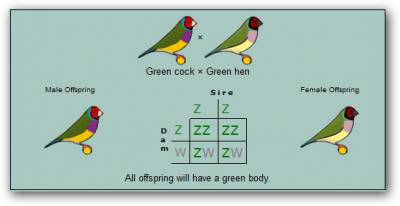
 × × Green cock × Green hen | ||||||||||||||||
Male Offspring |
| Female Offspring | ||||||||||||||
| All offspring will have a green body. | ||||||||||||||||
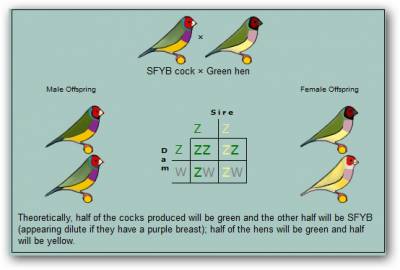
 × × SFYB cock × Green hen | ||||||||||||||||
Male Offspring  |
| Female Offspring  | ||||||||||||||
| Theoretically, half of the cocks produced will be green and the other half will be SFYB (appearing dilute if they have a purple breast); half of the hens will be green and half will be yellow. | ||||||||||||||||
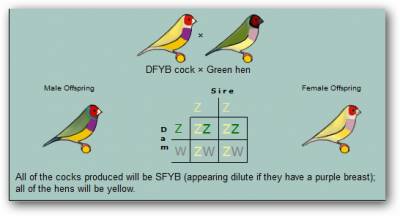
 × × DFYB cock × Green hen | ||||||||||||||||
Male Offspring |
| Female Offspring | ||||||||||||||
| All of the cocks produced will be SFYB (appearing dilute if they have a purple breast); all of the hens will be yellow. | ||||||||||||||||
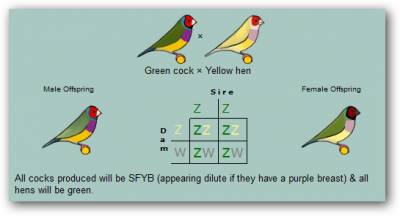
 × × Green cock × Yellow hen | ||||||||||||||||
Male Offspring |
| Female Offspring | ||||||||||||||
| All cocks produced will be SFYB (appearing dilute if they have a purple breast) & all hens will be green. | ||||||||||||||||

 × × SFYB cock × Yellow hen | ||||||||||||||||
Male Offspring  |
| Female Offspring  | ||||||||||||||
| Theoretically, half of the cocks produced will be SFYB (appearing dilute if they have a purple breast) and the other half will be DFYB; half of the hens will be green and half will be yellow. | ||||||||||||||||
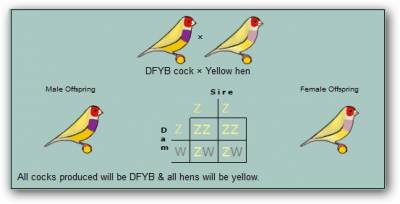
 × × DFYB cock × Yellow hen | ||||||||||||||||
Male Offspring |
| Female Offspring | ||||||||||||||
| All cocks produced will be DFYB & all hens will be yellow. | ||||||||||||||||
| DF-blue cock × DF-blue hen | ||||||||||||||||
| |
| | ||||||||||||||
| All birds produced will be DF-blue. The blue gene "transforms" a green bird to a blue one, a dilute cock to a pastel cock, and a yellow bird to a silver one. | ||||||||||||||||
| DF-blue cock × SF-blue (/blue) hen (or visa versa) | ||||||||||||||||
| |
| | ||||||||||||||
| Half of the birds produced will be DF-blue, half will be split to blue (SF-blue or /blue). In DF-blue birds, the blue gene "transforms" a green bird to a blue one, a dilute cock to a pastel cock, and a yellow bird to a silver one. | ||||||||||||||||
| SF-blue (/blue) cock × SF-blue (/blue) hen | ||||||||||||||||
| |
| | ||||||||||||||
| A quarter of the birds will be DF-blue, a quarter will not carry any blue at all; the other 50% of the birds will be split to blue (SF-blue or /blue), but there is no visual way to distinguish between /blue and birds not carrying any blue at all. In DF-blue birds, the blue gene "transforms" a green bird to a blue one, a dilute cock to a pastel cock, and a yellow bird to a silver one. | ||||||||||||||||
| SF-blue (/blue) cock × non-blue hen (or visa versa) | ||||||||||||||||
| |
| | ||||||||||||||
| Half of the birds will be split to blue (SF-blue or /blue) & half will not carry any blue at all, but there is no visual way to distinguish between /blue and birds not carrying any blue at all. | ||||||||||||||||
| DF-blue cock × non-blue hen (or visa versa) | ||||||||||||||||
| |
| | ||||||||||||||
| All birds produced will be split to blue (SF-blue or /blue). | ||||||||||||||||
All copyrights remain with Crystal and FinchInfo.com.
http://www.finchinfo.com/
